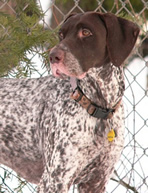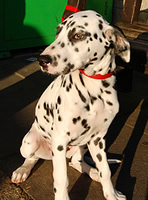
Dogs
The Nova Scotia duck tolling retriever is a new addition to the American Kennel Club and looks like a small golden retriever. This dog loves the water and is an excellent family pet.
The Nova Scotia duck tolling retriever, also called the toller, originated in Nova Scotia, Canada. They were developed in the early 1900s to toll (lure) ducks into shooting range and retrieve them from the water after being shot. The dog would run and play along the edge of the water in view of ducks, usually in response to the owner throwing sticks or balls. This playful activity would pique the curiosity of the ducks, which would then swim closer to see what was going on and be lured into shooting range.
Prior to the 1950s, the breed was known as the Little River duck dog or the Yarmouth toller. When the Canadian Kennel Club began registering the breed, the name was changed to the Nova Scotia duck tolling retriever.
In 2003, the Nova Scotia duck tolling retriever was accepted into the American Kennel Club as a member of the sporting group.
The Nova Scotia duck tolling retriever is a medium sized retriever that is the smallest of the retriever group. The dog looks similar to a small golden retriever. The head of the toller is wedge shaped and the triangular shaped ears are set high and fold forward. The facial expression appears somewhat sad but becomes very excited when the dog goes to work.
The coat of this retriever must be water-repellent and double to keep the dog warm when retrieving from icy waters. The double coat is medium length as soft. It is usually straight but may have a slight wave. The tail is well feathered. The color of the coat is a shade of red or orange with some white markings.
The adult Nova Scotia duck tolling retriever stands around 17 to 21 inches at the shoulder and weighs about 35 to 50 pounds.
The Nova Scotia duck tolling retriever is a fun-loving and affectionate dog but may be a little shy around strangers. The toller loves the water and is happiest when out on the hunt. As with other retrievers, this dog is playful and full of energy with a strong retrieving desire.
The toller is a loyal and loving family pet that loves to please. He does well with children, is patient and loves to play, especially fetch. The breed also gets along well with other pets in the family. When strangers approach, the toller will usually bark but rarely does anything more. He is a gentle dog that prefers to be with his family than alone.
The Nova Scotia duck tolling retriever is an intelligent dog and learns obedience quickly if handled properly. Young dogs tend to be easily distracted and take a firm but kind hand. The breed also tends to become bored with repetition so training sessions should be kept challenging and interesting. Tolling (luring) is an instinctual trait and cannot be learned.
The toller tends to become bored easily and needs lots of activity to keep him out of trouble.
The Nova Scotia duck tolling retriever is a breed that has few known diseases. The most common are hypothyroidism, hip dysplasia, autoimmune disorders and progressive retinal atrophy, a disease that causes nerve cells at the back of the eye to degenerate, leading to blindness.
The average life span of the toller is 12 to 14 years.
We realize that each dog is unique and may display other characteristics. This profile provides generally accepted breed information only.
 Labrador Retrievers: A guide to dogs and puppies of the Labrador Retriever breed
Labrador Retrievers: A guide to dogs and puppies of the Labrador Retriever breed
 Chinese Shar-peis: A guide to dogs and puppies of the Chinese Shar-pei breed
Chinese Shar-peis: A guide to dogs and puppies of the Chinese Shar-pei breed
 Berger Picard Breed Profile
Berger Picard Breed Profile
 Old English Sheepdogs: A guide to dogs and puppies of the Old English Sheepdog breed
Old English Sheepdogs: A guide to dogs and puppies of the Old English Sheepdog breed
 German Shorthaired Pointers: A guide to dogs and puppies of the German Shorthaired Pointer breed
German Shorthaired Pointers: A guide to dogs and puppies of the German Shorthaired Pointer breed
 Papillons: A guide to dogs and puppies of the Papillon breed
Papillons: A guide to dogs and puppies of the Papillon breed
 Dalmatians: A guide to dogs and puppies of the Dalmatian breed
The Dalmatian!
This breed was popularized by the Disney ani
Dalmatians: A guide to dogs and puppies of the Dalmatian breed
The Dalmatian!
This breed was popularized by the Disney ani
 Is a German shepherd Right for You? Survey Results from German shepherd Owners
Is a German shepherd Right for You? Survey Re
Is a German shepherd Right for You? Survey Results from German shepherd Owners
Is a German shepherd Right for You? Survey Re
 Black and Tan Coonhounds: A guide to dogs and puppies of the Black and Tan Coonhound breed
The Black and Tan Coonhound!
The Black and Tan coonhound is
Black and Tan Coonhounds: A guide to dogs and puppies of the Black and Tan Coonhound breed
The Black and Tan Coonhound!
The Black and Tan coonhound is
 Bluetick Coonhounds: A guide to dogs and puppies of the Bluetick Coonhound breed
The Bluetick Coonhound!
The Bluetick coonhound belongs to t
Bluetick Coonhounds: A guide to dogs and puppies of the Bluetick Coonhound breed
The Bluetick Coonhound!
The Bluetick coonhound belongs to t
 English Setters: A guide to dogs and puppies of the English Setter breed
The English Setter!
The English Setter is a bred for a mix
English Setters: A guide to dogs and puppies of the English Setter breed
The English Setter!
The English Setter is a bred for a mix
Copyright © 2005-2016 Pet Information All Rights Reserved
Contact us: www162date@outlook.com